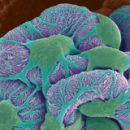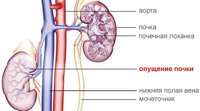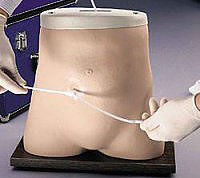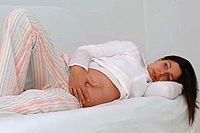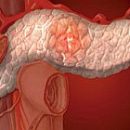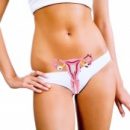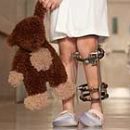Urolithiasis is known with deep antiquity. Urinary stones found people from the Egyptian mummies, dead and buried before our era. Recently, there has been an obvious growth of this pathology in all regions of the world. According to various authors, urolithiasis occurs at least 1-3% of the population. Why are kidney stones formed?
Content
Causes of the formation of kidney stones
The unified adopted concept of etiology and pathogenesis of the disease does not exist. Urolithiasis or kidney stones is a multi-dyed disease. Under certain conditions created in the body, stone formation can cause one, less often - several factors. List the main. It has long been proven that one of the main factors is the high content of mineral salts in drinking water. Therefore, this disease is most often found in the regions where the water is tougher.
Urinary stones are formed in the urinary tract: in a cup, lochank, bladder. Thus, the violation of the outflow of urine is the most important etiological moment in the process of formation of the concrement.
It has been proven that the lack of vitamin A leads to the formation of stones in the urinary system.
Another important reason is the local urinary tract infection. Moreover, a specific microbe does not exist, any infection can lead to urolithiasis. That is why it is so important in a timely and adequately to treat the inflammatory process in the kidneys and urinary tract. Be sure to hold this treatment, taking into account the results of urine tests, bacterial crops and sensitivity of the pathogen to antibiotics.
Often, endocrine diseases lead to the emergence of this disease, various exchange violations.
In addition, the cause of kidney injuries, bones may be; contribute to the formation of stones and some drugs.
Anatomy of the genitourinary system
Clinical symptoms of the disease largely depend on the localization of the stone in the urinary trait. Therefore, before describing the symptoms, it is necessary to present the anatomy of the urogenital system.
The urinary system includes kidneys, ureters, bladder and urethra.
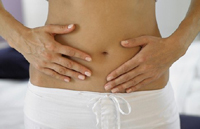 The kidneys are a paired organ and are located in the lumbar region. They lie on the sides of the spine at the level of the 1st and 2nd lumbar vertebrae. Right kidney usually for several centimeters below the left.
The kidneys are a paired organ and are located in the lumbar region. They lie on the sides of the spine at the level of the 1st and 2nd lumbar vertebrae. Right kidney usually for several centimeters below the left.
Kidneys have a form of a large bob. The surface of their smooth, dark brown, the outer edge is convex, internal - concave. In the field of the inside edge there are gates in which the renal vein includes renal artery, nerves, lymphatic vessels and ureter. Blood kidney system is very developed. Renal artery has a mighty tree.
Outside the kidney is covered with a fibrous shell, there is a fat layer above it, and the front and rear of the kidney is covered with fascia.
Renal fabric on the section consists of two layers: outdoor - cortical and internal - cerebral. The cortical layer contains renal calf and is divided into slices.
The brain layer consists of collective tubuages and is divided into education, called pyramids. The bases of the pyramids are addressed to the outer surface of the kidney, and its tops - to sinus. The tops of several pyramids are usually connected in the formation, called pupils. Each nipples permeated by holes of collective ducts opening into small cups. Several cups are combined in 2-3 large cups, which in turn go into a loyalty. Renal Lohanka continues to the ureter.
The main structural unit of the kidneys is nephron consisting of renal calf, convinced tubules and loops Genley. Each kidney contains up to 2 million nephrons.
The physiology of the kidney is very complex and not fully studied. The main task of the kidneys is the allocation of used protein metabolism from the body, including nitrogenous substances.
To allocate up to 1.5 liters of urine per day, the kidneys have to be filtered up to 100 liters of blood. The intensity of blood flow in the kidney is so large that almost 20 times the intensity of the blood circulation of any organ. The kidneys passes through themselves every 7 minutes. All blood volume.
Symptoms of urolithiasis
Let's go back to clinical symptoms of urolithiasis. The manifestations of the disease largely depend on the location of the stone, but at any localization there may be pain in the lower back and pathological changes in the urine. If the stone is located in a cup, then the pain appear only when the stone is shifted to the neck of the cup, when there is an increase in the intravenous pressure. As soon as the outflow violation is liquidated, the pain syndrome immediately subsides. If you find a stone in the skirt of the kidney of pain. The displacement of the stone in the ureter can lead to the development of renal colic - the main manifestation of the urolithiasis (with kidney stones, it is observed in 50% of patients, and at 95-98% of the ureters). The acute violation of the outflow of urine, due to the blockage of the ureter, leads to the stretching of the locher and the kidney capsule, which causes the strongest pain, which from the waist along the ureterals is irrades to the inguinal region and the genitals. The attack of urolithiasis or colic arises, as a rule, suddenly, without visible reasons; Sometimes a provoking role is played by exercise, shaking when driving on a bike or motorcycle on an uneven road and other. Pains are so intense that make the patient rushing in search of poses to reduce them. The patient who suffered a kidney colic, for many years he remembers this painful pain and is also afraid of repetition. The typical manifestation of the attack is both a violation of urination manifested by frequent painful urges. Renal colic may be accompanied by chills, fever, acceleration of ESP, leukocytosis and hematuria. Often it proceeds with a symptom complex of acute abdomen, which requires differential diagnostic search.
Diagnosis of urolithiasis
Diagnosis of urolithiasis only on the basis of clinical symptoms is impossible. Accurate diagnosis is established after radiological and ultrasound examination methods. X-ray-contrast stones (oxalate and phosphate) are clearly visible on sightsets. Uraban, protein, cysteine and xanthine stones are unnecessary in a review picture and are therefore called x-ray.
Often the diagnosis becomes clear after the ultrasound study of the kidneys. When sonography, it is possible to detect both x-ray and x-ray concreting. Ultrasonic detection of coral stone is usually not difficult. With sonography, it looks like an echogenic structure that fills the entire cup of the kidney fully.
Ultrasound and X-ray studies are complementary methods and in obscure cases should be carried out in parallel.
Treatment of urolithiasis
Treatment of urolithiasis is most often comprehensive: drug, operational, instrumental, physiotherapeutic, spa, dietary. True, in recent years, doctors, as a rule, stopped recommending strict diets. The drugs that are used for all forms of urolithiasis include angioprotectors, antiagregants, anti-inflammatory, diuretic, antispasmodics, vegetable preparations. In addition, the federal industry standard for urolithiasis includes vitamins of group B, E and K, antiforms and sedatives. Only the high professionalism of the doctor and the clear idea of the stage of the disease will allow you to choose the right therapeutic tactics and avoid polypragmasia leading to the high cost of course treatment and the emergence of unwanted and dangerous complications.
In the case of detection of uragany stones, it is corrected by the violations of purine metabolism and are prescribed litholitic agents. To do this, use drugs that reduce the formation of uric acid, stimulating its excretion, and citrate mixtures that increase the pH of urine. The most striking representative of the first group of drugs is allopurinol, which has the ability to inhibit the enzyme xantina oxide and reduce the formation of serum urates, preventing their kidney deposition. Bennzobromaron has a pronounced uricosuric effect due to mainly inhibition of the absorption of uric acid in proximal kidney channels and an increase in its highlighting by the kidneys. With the aim of litholithization of renal concrections consisting of urates, citrate mixtures are prescribed (briemagne, uralitis), the use of which is often successful. In relation to other types of stones, grinding drugs use almost impractical.
How to stop the attack of the kidney colic
Treatment of the attack of the renal colic is aimed at eliminating the reflex spasm of smooth muscles of the renal loin and ureter, the relief of pain syndrome. To this end, thermal procedures are used, analgesics (before their purpose it is necessary to eliminate the presence of other pathology and complications of urolithiasis, such as pyelonephritis) and spasmolytics. Traditionally, m-cholinoblocators are used as the latter (atropine, platiphyllin, metacin) and drugs of myotropic effects (hydrochloride doll). They are often prescribed in combination with analgesic metamizol and administered parenterally. In the absence of effect, opioid analgesics are used (preference is given to drugs that provide antispasmodic effect on ureterals, - Promedol and Gunopon). With the ineffectiveness of conservative therapy to restore the passage of urine, the catheterization of the ureter and endoscopic removal of stone or operational treatment are carried out.
 With infectious-inflammatory processes in the urinary system, it is necessary to assign antibiotics after bacteriological studies of urine and detect the sensitivity of the dedicated pathogen to a specific drug. Courses of antibacterial therapy without these methods are often completely useless and lead to the development of dysbiotic effects and resolved decrease in immunity.
With infectious-inflammatory processes in the urinary system, it is necessary to assign antibiotics after bacteriological studies of urine and detect the sensitivity of the dedicated pathogen to a specific drug. Courses of antibacterial therapy without these methods are often completely useless and lead to the development of dysbiotic effects and resolved decrease in immunity.
In the future, the patient is desirable to appoint medicinal products of plant origin. Frequently use fees whose components are selected taking into account pharmacological effects. Apply medicinal plants with diuretic, anti-inflammatory, antiseptic effect, as well as contributing to the removal of small-sized stones or sand. Diuretic Effect of Juniper, Parsley, Birch Leaves, Field Cupboat due to the presence of essential oils, saponins, silicates in them. The presence of tannins and waterbutin in tolnican, pear and leaf bruborries provides anti-inflammatory effect. Chamomile and floor-floor-containing phytoncides possess antiseptic properties, and rosehip, cornflower, dyeing and nettle dysple and nettle, due to the removal of salts and uric acid - litholitic. The duration of course therapy is strictly individual. Efficiency criteria are necessarily evaluated by adequate control methods.
Only those patients who have dimensions and shape of the stones should be sent to the balneological resorts, as well as patients 1.5-2 months after removal of stones with operational or conservative way.
Until 1980. The priority method of treating nephrolithiasis was the operational removal of stone. High traumaticity and low efficiency, a large percentage of relapses served as a motive for finding fundamentally new approaches to solving this problem.
Since 1980. In Germany (and from 1987. Both in Russia) a fundamentally new method of treating urolithiasis is used - remote shock-wave lithotripsy. To date, the method has become leading in the treatment of this category of patients and is used in 80-90% of patients. Open surgical operations are only 10-15%.
Further progress of the treatment of urolithiasis was introduced into the practice of minimally invasive endoscopic methods.
Paraffin and stones
In the past three years, a new non-invasive method for the treatment of urolithiasis developed by the Russian company has become widely applied in Russia «Fisomed». The essence of the method is to use for the destruction of stones in a specially treated paraffin. Unique technological processing made it possible to significantly increase and fully realize its ability to positively influence the urinary system. Plates from this substance are superimposed on the body in the field of kidneys for a long time (from several months to a year or more). As a result of constant therapeutic effects, the functional ability of the kidneys is increasing, urodynamics is improved, manifestations of the inflammatory process. The stone under the influence of paraffin liners is gradually collapsed and in the form of sand is highlighted with urine. The absence of a harmful effect on the human body in combination with the maximum healing effect allows to apply the method without any restrictions, and the possibility of its use in outpatient conditions can significantly expand the arsenal of urologists clinic.
Urology of the current millennium will undoubtedly be preventive and rely on the methods of preventing and early detection of diseases. The emergence of new technologies in the treatment of urolithiasis makes it possible to note the trends that will dominate and in subsequent years. Their main focus, according to the chairman of the Russian Society of Urologov Acad. Ramne N.BUT. Lopatkin, you can determine the formula: «Achieving the maximum result with minimal invasion and the cost of the procedure».

